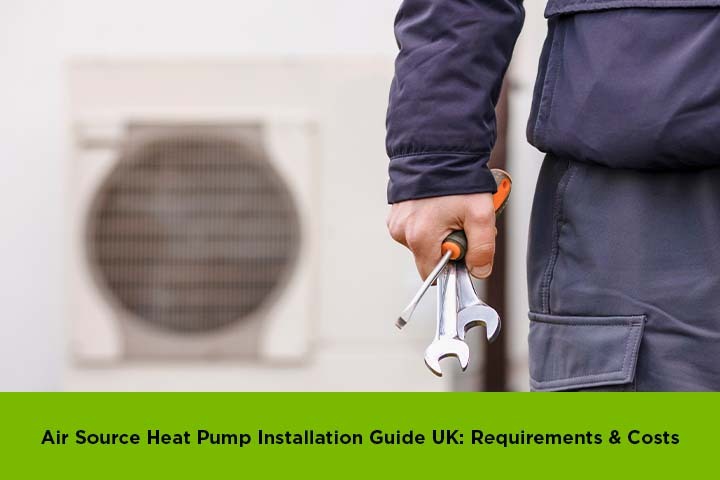Heating your home can cost a lot in the UK. Many people now want cheaper and greener options. One great option is an air source heat pump. It uses outside air to warm your home and water.
This is more eco-friendly than gas or oil heating. Many UK homes can now switch to this new system. In this guide, you will learn about installation, rules, costs, and support. Everything is written simply, so anyone can understand.
What Is an Air Source Heat Pump?
An air source heat pump draws heat from the external air. It does not cease operating when it gets cold. This heat is used to warm your home and your hot water. It is like a fridge but in reverse. It runs on electricity but is very efficient.
It gives more heat than the electricity it uses. This helps reduce your energy bills. It also helps cut down on carbon emissions. It is good for the planet and your wallet.
How Does It Works
The heat pump pulls in outside air using a fan. It then compresses the air to increase heat. That heat moves into your home’s heating system. It works well with underfloor heating or radiators.
The system also heats water for showers and taps. It can keep running in cold UK weather. It doesn’t need gas or oil to work. This means you can save money and reduce pollution. You also avoid rising gas prices.
What Are the Requirements for Installation?
Your home must meet certain rules before installation. You need space outside for the heat pump unit. It must have good airflow and not be blocked. Your home should have good insulation first. This helps keep heat in and lowers energy use.
A proper survey checks your home’s heating needs. The installer will also check your radiators and pipes. Some homes may need upgrades before fitting the pump. Planning permission is not always needed. But listed buildings may need approval.
What Type of Homes Can Get a Heat Pump?
Most UK homes can get a heat pump fitted. Both old and new homes may be suitable. Homes with space outside are best for the unit. Flats may need special checks or landlord permission. It is easier in houses with back gardens.
Homes with good insulation work better with heat pumps. If your home is cold and draughty, it may waste heat. Your installer will tell you what upgrades are needed. You don’t need a big home, just a good setup.
How Much Does the Heat Pump Installation Cost?
Air source heat pump installation costs between £7,000 and £13,000. The price depends on your home size. Bigger homes need larger pumps and more work. Some homes also need new radiators or pipework. That can increase your cost.
The cost of engineer, survey, and equipment are all included in the price. It may seem high at first. But you save more in the long run. Running costs are low, and maintenance is simple. It also lasts 15 to 20 years with good care.
Are There Any Grants or Help Available?
Yes, the UK government offers grants for heat pumps. The main scheme is the ECO$. It covers 100% to help pay for a heat pump. You must own the home and have a working EPC. Your home must also meet insulation standards.
The grant pays money directly to the installer. You pay the rest if needed. This makes it more affordable for many families. Some local councils also give help. Always check before you install the system.
What Are the Running Costs?
Running a heat pump costs less than gas or oil. It uses electricity, but very efficiently. You get about three units of heat from one unit of power. This means lower bills each month. You can save more if your home is well-insulated. If you use solar panels, the cost can drop further. You won’t need to pay for gas supply either. Maintenance costs are also low each year. This makes it a good long-term investment.
What Is the Installation Process Like?
First, a trained installer visits your home for a survey. They check space, insulation, and heating needs. Then, they design the right system for your home. On installation day, they fit the outdoor unit first.
They also work on indoor parts like pipes and radiators. It takes about 2 to 5 days to complete. You may be without heating during that time. After fitting, they test the system. You will also get instructions to use it easily.
Do You Need Planning Permission?
Most air source heat pumps don’t need planning permission. They are allowed under permitted development rules. But some conditions must be met. The unit must be placed far from neighbours. It should be located at the side or the back of your home.
If your home is a listed building you may need a special licence. Always check with your local council just in case. Getting permission before work starts avoids future trouble. Your installer can also help with this process.
What Maintenance Is Needed?
Air source heat pumps need little maintenance. You should clean the fan and check for leaves or snow. Get a yearly service from a qualified engineer. They check the parts and make sure it works well.
This helps keep the pump running longer. You don’t need to worry about gas safety checks. It has fewer moving parts than gas boilers. Keep vents clear and report strange noises. With care, the system works for 15 years or more
Are Heat Pumps Noisy?
They reduce carbon emissions and use clean energy. They help fight climate change and pollution. They also lower heating bills in the long term. The system works all year, even in winter.
It heats both your home and your water. You no longer rely on gas or oil. You can pair it with solar panels for better savings. Many UK homeowners now switch to heat pumps. It is good for the planet and your pocket.
What Are the Benefits of Air Source Heat Pumps?
They reduce carbon emissions and use clean energy. They help fight climate change and pollution. They also lower heating bills in the long term. The system works all year, even in winter.
It heats both your home and your water. You no longer rely on gas or oil. You can pair it with solar panels for better savings. Many UK homeowners now switch to heat pumps. It is good for the planet and your pocket.
Are There Any Downsides?
Initial costs can be high without a grant. Not all homes are ready for a heat pump. You may need better insulation or new radiators. Heating may feel different compared to gas boilers. It works slowly but keeps steady warmth.
Some homes need space for the unit. You must also choose a trusted installer. Bad installation reduces efficiency. But most downsides are fixable. With the right setup, heat pumps work very well in UK homes.
Conclusion
Air source heat pumps are a smart choice for UK homes, as they save money and protect the environment. Installation needs planning and a proper survey. Costs are high at first, but grants help reduce them. You also save money every month after.
Prepare your home first. Talk to a skilled fitter who knows your region. Your home will keep warm all year round with the right care and support. The heat pumps of the future for green home heating in UK.
FAQs
You require effective home insulation for the loft and walls, a good external space, and a registered installer who qualifies for all the UK heat pump installation standards.
These range from £7,000 to £13,000 but the price can be brought down by government grants such as the ECO4 programme to nil.
They reduce energy bills, reduce carbon emissions, perform well during cold snaps, and require less maintenance compared to aging heating systems.
Most UK homes don’t need planning permission, but listed buildings or special locations may require local council approval.
Modern units are quiet, and regular maintenance keeps them running efficiently for up to 20 years.







